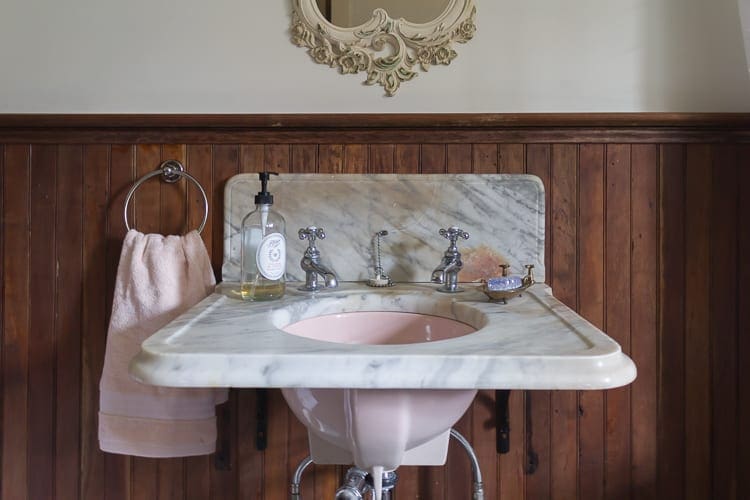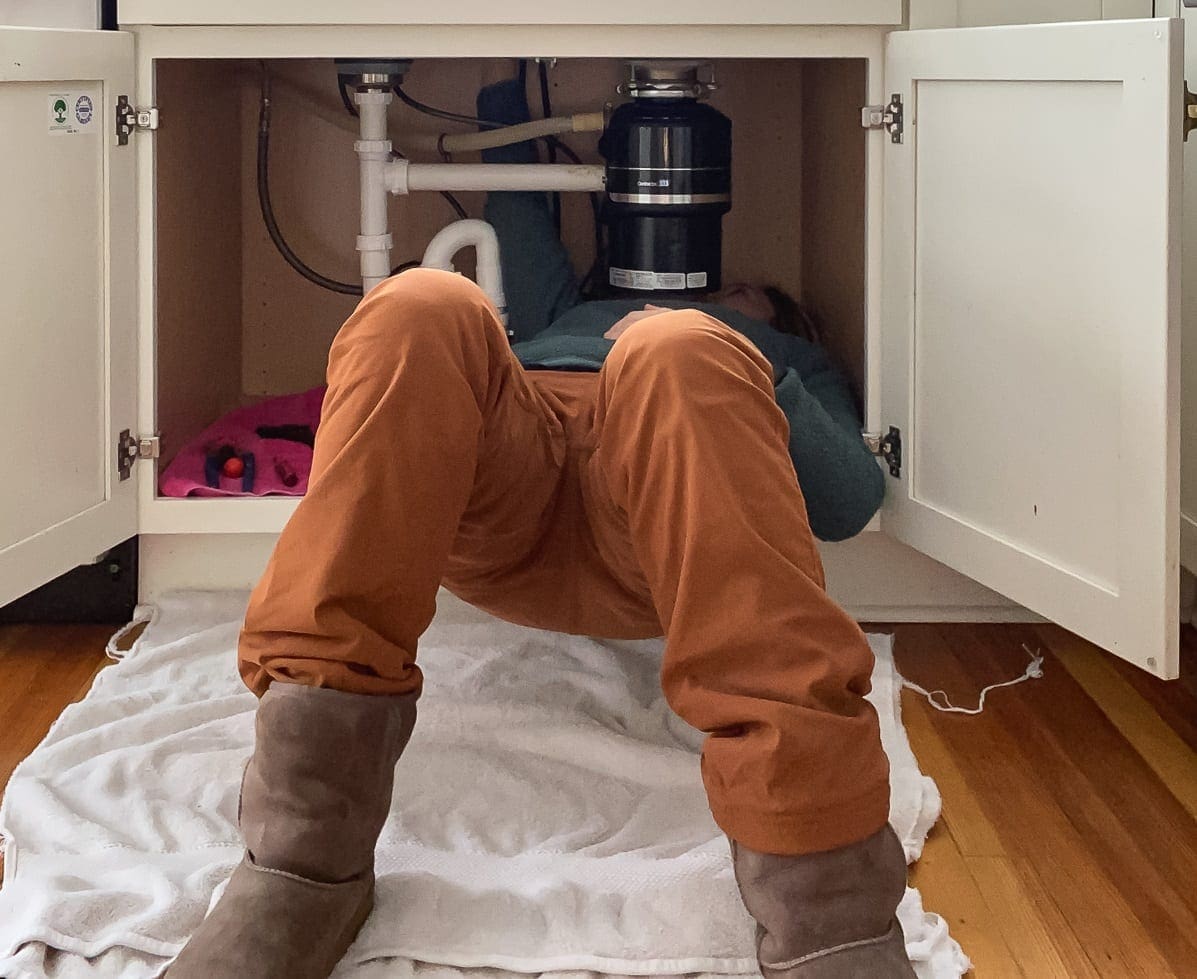A few years ago, I started researching how to restore an antique marble sink, and I filed away a few ideas. However, until we renovated the Scary Bathroom, all of those ideas were untested. BHH predates indoor plumbing, and our sink was likely installed around the turn of the 20th century. That means it is over 110 years old!
During this project, I took one for the DIY team and tried all the things. Even though some of the products did not produce remarkable results on this sink, they may work on a different marble cleaning project down the road. Restoration work always feels like 10% product, 80% problem-solving, and 10% frustrated crying, but perhaps that last percentage only applies to me.
This post contains affiliate links.
Step 1: Disassemble the Sink and Remove the Basin
The first thing I did was unscrew all the hardware and remove the basin.
The pink basin was held in place by three brackets underneath.
They were easy enough to unscrew by loosening the small square nut.
I carefully removed the drain from the sink. Then, I unscrewed the faucets, set everything aside and snapped a photo. During disassembly, I like to take pictures of critical hardware and how it fits so I will remember how to put everything back together again. Some people are naturally intuitive about this sort of thing. I am not.
Andy recently replaced the water lines and faucets, so I kept them. The faucet nuts and the chrome drain pipes were too corroded to reuse, so I tossed them and bought new ones.
Step 2: Cleaning the Marble
Before I addressed the stains, I cleaned the marble well with diluted hydrogen peroxide (50/50 mix). I also gently scraped off all of the old plumber’s putty, caulk, and mold.
Except for the rust, all of the other stains were unidentifiable, so I used a variety of products ranging from gentle to aggressive and evaluated the results separately.
I applied them in the following order:
Baking Soda (gentle)
Following Amy’s tutorial, I applied a baking soda poultice to the entire top, and I covered it all with plastic. I gave the baking soda poultice method three tries, but the stains were still quite visible. The left side of the shot below shows the results after the third application.
OxiClean (more aggressive)
After the baking soda, I tried OxiClean powder that I mixed into a paste. I followed the mixing and application directions for brightening tile and grout listed on the container. Since I was unsure what would happen, I decided to apply the paste to only the darkest stains as a trial. I was afraid that if the OxiClean worked in some places and not others, the marble surface would start to look mottled.
After one hour, the stains were only marginally lighter, so I did not apply more for a second try.
Naval Jelly (very aggressive)
Once I rinsed the OxiClean off the marble thoroughly, I applied Naval Jelly to the rust spots only. Using Naval Jelly on marble is an off-label use, but the Natural Stone Institute endorses the very careful use of Naval Jelly. Naval Jelly is a strong acid that dissolves rust, and it should always be applied while wearing a pair of chemical-resistant gloves. (I like these because they are available in size medium which fits my small hands better.)
I left the acid on for the minimum recommended amount of time twice. Nothing happened.
TeRust Rust Remover (aggressive)
Next up? TeRust rust remover. I had high hopes for this product because it is made specifically for rust stains on marble. I followed the manufacturer’s directions, and I also tried two applications.
The TeRust poultice powder did draw out some of the rust. For the first time since I started the project, I thought to flip the backsplash over to inspect the back. That’s when I discovered that the rust was not a surface stain. I could see it on the back too. The rust was pervasive which is why none of the poultices worked very successfully.
Oxalic Acid (very aggressive)
Since there was no way that the rust was coming out, I decided to try lightening the entire surface with Oxalic Acid (sometimes labeled wood bleach) instead. I followed the package directions by dissolving the crystals in hot water and washing the surface every ten minutes until I was happy with the results. By far, the Oxalic Acid was the most effective product I tried.
Knowing what I know now, next time I will likely use only these three products:
- Baking Soda for general cleaning
- TeRust Rust Remover for surface rust stains
- Oxalic Acid to lighten and brighten the entire surface
There was no harm using the OxiClean and the Naval Jelly, but they did not do anything remarkable either. I had both on hand, and I gave them a shot.
Step 3: Buff, Clean, and Seal
Once I realized that I had taken the stain fighting process as far as I could, I rubbed the entire surface vigorously with 0000 steel wool. My goal was not to make the marble gleam. I just wanted a soft sheen and a smooth surface.
Then, I cleaned the sink top one final time with Granite Gold daily cleaner. Finally, I applied three coats of Granite Gold sealer to protect the top from future toothpaste, hairspray, and shaving cream spills.
Before-and-Afters
When I am in the thick of restoration work, I sometimes look too closely at the project. I don’t always notice the progress until I see the before-and-after photos.
This was my first opportunity to restore an antique marble sink top. Overall, I am very pleased with the results. From now on, we will be taking good care of the marble on a daily basis, and sealing it regularly too. Proper routine maintenance makes all the difference. Isn’t that true for almost everything in life?
Do you have an antique marble sink in your house? Are there any other marble restoration tips or tricks you would like to add? Please let me know in the comments.

PS: If you plan to restore an antique marble sink, be sure to pin this article for later, and feel free to use the graphic below.





















11 Comments
Devyn
I am guessing some folks won’t see much of a difference in the before and after, but it is rather dramatic knowing how hard it is to get stains out of old marble. I think your final conclusion to use baking soda, TeRust Rust Remover, and Oxalic Acid is great.
As for the major rust spot, it looks as though there is/was a metal pin used to align the backsplash with the sink top and the rust came from within, and there is no way you could have ever gotten it out. But you did lighten it up quite a bit.
If only they had used brass pins?
Stacy
It really is so hard to get the stains out. Also, you are right about the pin. The pin on the other side is gone, but the one on this side rusted through. Darn it!
gigi
Do you think the acid wash would work on a fireplace surround stained by the smoke from frequent wood fires?
Stacy
I think this oxalic acid might leave a white residue behind on brick. Have you tried diluted Dawn dish washing detergent? I had some luck with that on the brick of our fireplaces.
gigi
sorry, I forgot to tell you the fireplace surround is marble.
Stacy
The Oxalic acid should work great then! I also found this link that might be helpful:
https://www.oldhouseonline.com/repairs-and-how-to/cleaning-marble-mantel
Vanessa
That actually made a pretty big difference to the overall look. Lots of work, I know but I think it was worth it!
Stacy
Thank you, Vanessa.
Shannon
I used a fine grit mouse sander, this worked great at resurfacing the marble sink. I then used soft scrub bleach with a fine steal wool, sinuses and repeated a couple more times. The rust and chemical stains were basically gone, there are some but I doubt all of it will come out. I then polished with a rotary polish tool till I was satisfied then sealed a couple of times. Not sure about putting the sander in it, but it did wonders for removing old stains and the bleaching did the rest. I will try 12% hydrogen peroxide on my other sink and the oxide acid on my other sink, see how that goes. The light standing was the best though.
Stacy
Great ideas!